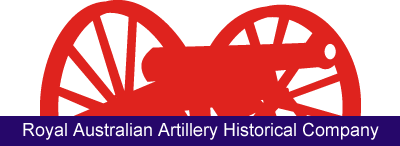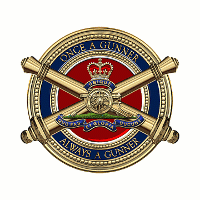In 1934 he attended his first camp at Crows Nest, Queenscliff from where they used to fire onto Swan Island as an impact area. He obviously displayed some military potential as he was promoted to Bombadier in the December of that same year and Sergeant in May 1937. In 1938 and 1939 he attended a commissioning course which he completed in July 1939, attaining the rank of Second Lieutenant.
Ernest enlisted in the 2nd Australian Imperial Force on the 13th of October 1939 with the number VX 116 meaning he was the 116th person to enlist in Victoria after the declaration of War on 3rd September 1939, As a gunner he was allocated to the 2/3rd Field Regiment, 6th Division based in Liverpool, NSW.
On the 28th March 1940 the 2/3 Field Regiment marched through Sydney and sailed for England on the Queen Mary in early May, arriving in Scotland on the 17th June 1940 then travelling south to the Aldershot area for further training.
Early in his army life Ernest must have displayed an aptitude for staff work as on 21st June 1940 the then Lt McNamara was tentatively appointed as Intelligence Officer Royal Australian Engineers and Passive Air Defence Officer, HQ Australian Imperial Force(AIF) and seconded from his Regiment. On the 1st September 1940 he was promoted Temporary Captain as General Staff Officer Grade Three at HQ AIF.
Ernest left the UK by ship on the 14th November and disembarked in the Middle East on the last day of 1940 and was seconded to HQ 9th Australian Division Cyrenaica and moved with the HQ to Tobruk where the siege commenced on 11th April 1941, the operation is being commanded by 9 DIV under the leadership of Major General Leslie Morehead. Unfortunately the desert conditions were not good for his health and on 20th June 1940 he was evacuated to 7th Australian General Hospital in Palestine with pneumonia and Empyema and remained in Hospital for the next three months.
He then spent one month in the 1st Australian Convalescent Depot before re-joining his Regiment in Khassa Palestine on the 17th October 1941.
After the bombing of Pearl Harbour on 7th December 1941 and the declaration of war with Japan the Australian Forces in the Middle East were recalled to Australia. The 2/3rd Field Regiment embarked on the Durban castle on 16th February 1942 in Suez and disembarked in Adelaide a month later. During his leave Ernest on 30th April married the love of his life Irene Walsh.
During his leave after his wedding he is posted as Battery Captain 53 Battery 2/3 Field Regiment and the Regiment is re-located to Townsville being complete there by 3rd June 1942. On the 28th June Ernest is appointed General Staff Officer Grade 3 Operations HQ 1 Australian Army located somewhere in Northern Australia and on 26th September this is upgraded to General Staff Officer Grade 2 Operations, he is promoted to Major and deployed to HQ New Guinea Force. He does not re-join his Regiment but serves the remainder of the War in operational staff appointments.
For two months in from January to March 1943 he performed the duties of Liaison Officer with US 41 Division during the Buna, Gona, Sanananda Campaign for which he received a Letter of Commendation from Major General H.N.Fuller, Commanding General 41 Division and in June 1944 he is Mentioned in Dispatches and selected to attend the US Army Staff Course at Fort Leavenworth Kansas which during WWII was a 5 month Course. He travels over by air but returns on the SS Monterey. On his return to PNG he is allotted for duty as General Staff Officer Grade 2 HQ 3 Australian Division on Bougainville.
After the Japanese surrender he serves on in Australia as GSO2 (Operations) Land Headquarters Australian Military Forces. Some time in early 1947 Ernest meets LTCOL Jimmy Harrison, (another gunner and eventually Major General and Governor of South Australia) in Melbourne City who he worked for during the latter part of the War who suggests that he joins the Interim Army instead of de-mobilising. Ernest thinks this is a good idea as he is not looking forward to resuming civilian life. This all works and he becomes a Major in the Interim Army and is posted as General Staff Officer Grade 2 Military Operations and Plans Army Headquarters Melbourne. He is promoted Lieutenant Colonel in June 1950 while holding the appointment of Deputy Assistant Adjutant General (DAAG), Directorate of Personal Administration (DPA) Army Headquarters.
In 1953 and 1954 he is posted as the Australian Instructor at the British Army Staff College Camberley UK. A highlight of his time in the UK was being asked to perform the duties of Marshal at the Coronation of Her Majesty Queen Elizabeth II for which he is awarded the Coronation Medal. Before returning to Australia in September 1955 he completed parachute Training in the UK at Old Sarum on Salisbury Plains as he was posted as Commanding Officer School of Land Air Warfare RAAF Base Williamtown a forerunner of the Joint Warfare Establishment. He served in this position until January 1958 when he is posted as Commander Australian Army Force, Far Eastern Land Forces (FARELF), Singapore and is promoted Colonel. His duties include national command responsibilities for the Australian Infantry Battalion, then 3 RAR, operating in Malaya against the Communist Terrorists of Chin Peng as part of the 28th Commonwealth Infantry Brigade based at Terendak Garrison, Malacca.
On his return from Singapore in February 1960 he is posted as Deputy Director Military Training Army Headquarters which at that time is still in Melbourne but only until October when it moves to Canberra.
In December 1960 he is very pleased to be posted out of Canberra to a to a field position as Commanding Officer 2nd Battalion Royal Queensland Regiment(RQR) and Area Commander Northern Queensland Area and be back working with the CMF which he originated from. After two very busy and enjoyable years in this appointment he is posted back to Army Headquarters Canberra as the Director Administrative Plans AHQ(C) which he holds for one year until January 1966 when he is appointed Director of Military Training AHQ(C) and promoted Brigadier.
In early 1968 he is appointed Australian Army Representative (AAR) Australian Army Staff (UK) and takes the opportunity to travel to the UK with his wife and the two children still at home by sea on the MS Oriana. In December 1969 he relinquished position of AAR AAS(UK) and he and the family returned by air in time for my Graduation from RMC on 9th December 1969.
His final posting in the Army is Deputy Quarter Master General AHQ(C) which he held for 18 months until he reached his retirement age of 55 on the 7th September 1971.In accordance with the custom of the time he is granted the Military Title of Brigadier and placed on the Retired List Eastern Command.
From not long after his retirement from the Army until he reached the Public Service Retirement Age of 65 years on 7th September 1981 he works as a Public Servant filling the position of Co-ordination Officer at The Joint Services Staff College, Weston Creek a position he enjoyed greatly as it kept him in the military loop.
Ernest McNamara provided service to our nation from 3rd October 1933 when he joined the Militia at age 17 to 7th September 1981 when he retired from the Public Service at age 65, a total of 47 years, 11 months and 4 days. Quite a remarkable achievement and recognised in the Queens Birthday Honours of 1983 when he was awarded Membership of the Order of Australia (the AM) for his service to Australia. |


